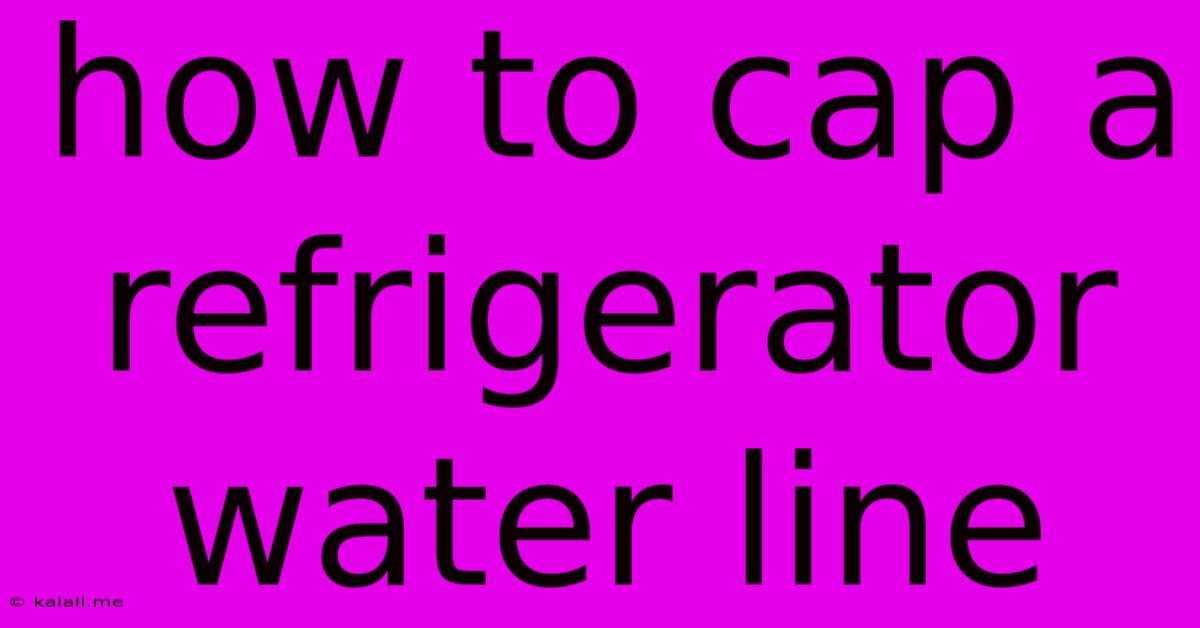How To Cap A Refrigerator Water Line
Kalali
May 31, 2025 · 3 min read

Table of Contents
How to Cap a Refrigerator Water Line: A Step-by-Step Guide
Meta Description: Learn how to safely and effectively cap your refrigerator water line. This guide provides a step-by-step process, essential tools, and safety precautions for a successful DIY project.
Cutting off the water supply to your refrigerator is often necessary when replacing appliances, performing repairs, or simply removing the water dispenser feature. Knowing how to properly cap a refrigerator water line is crucial to prevent leaks and potential water damage. This comprehensive guide will walk you through the process, ensuring a safe and efficient outcome.
Understanding Your Refrigerator's Water Line
Before you begin, it's important to locate and identify your refrigerator's water line. This is typically a thin, flexible tube connected to the back or bottom of your refrigerator, leading to a nearby water supply. Understanding the type of connection (compression fitting, quick-connect, etc.) will determine the appropriate capping method. Always turn off the water supply to the refrigerator before starting any work. This is usually a shut-off valve located beneath the sink near the water line connection.
Tools and Materials You'll Need
Gathering the necessary tools beforehand will make the process smoother and more efficient. You'll typically need:
- Appropriate capping device: This depends on the type of water line connection. Options include compression caps, quick-connect caps, or a simple plug if the line is cut.
- Water shut-off valve: Ensure this is working correctly before you begin.
- Adjustable wrench or pliers: To tighten or loosen the water line connection.
- Towels or rags: To clean up any spills.
- Bucket or container: To catch any remaining water in the line.
- Optional: Teflon tape: For added sealing security (especially with compression fittings).
Step-by-Step Process of Capping the Refrigerator Water Line
The exact steps may vary slightly depending on your refrigerator model and the type of water line connection. However, the general process remains consistent:
-
Turn Off the Water Supply: Locate the shut-off valve under your sink and fully turn it off.
-
Disconnect the Water Line: Carefully disconnect the water line from the refrigerator. If you have a quick-connect fitting, this usually involves pressing a release tab or lever. For compression fittings, use the appropriate wrench to carefully loosen the nut.
-
Drain Remaining Water: Hold a bucket or container under the disconnected line to catch any remaining water.
-
Prepare the Water Line for Capping: If necessary, carefully trim the end of the water line to create a clean, even surface for your cap.
-
Install the Cap: Attach the appropriate cap to the end of the water line. For compression caps, wrap Teflon tape around the threads before tightening. Tighten securely, but avoid over-tightening, which could damage the line.
-
Test for Leaks: Turn the water supply back on slowly and carefully check for any leaks around the capped connection.
-
Secure the Line: Once you've confirmed there are no leaks, you can neatly secure the capped water line, possibly using a zip tie or tape to keep it away from moving parts of the refrigerator.
Troubleshooting and Safety Precautions
- Leaking Cap: If you notice a leak, immediately turn off the water supply and re-tighten the cap or replace it if necessary. Check for proper sealing and ensure the correct type of cap is used.
- Damaged Water Line: If the water line is damaged, it's essential to replace the entire line to prevent future leaks. Consult a professional if you are uncomfortable working with plumbing.
- Safety First: Always turn off the water supply before starting any work. Be cautious when handling water lines and tools to avoid injury.
By following these steps and safety precautions, you can confidently cap your refrigerator water line and prevent potential water damage. Remember, if you're uncomfortable performing this task, it's always best to consult a qualified plumber.
Latest Posts
Latest Posts
-
What Does It Mean When Sampling Is Done Without Replacement
Jun 02, 2025
-
How To Remove Labels On Wine Bottles
Jun 02, 2025
-
How To Backfeed A Generator To Your House
Jun 02, 2025
-
Invalid Character Data Corresponding To Xml Entity
Jun 02, 2025
-
Ac Keeps Running Even When Temp Is Reached
Jun 02, 2025
Related Post
Thank you for visiting our website which covers about How To Cap A Refrigerator Water Line . We hope the information provided has been useful to you. Feel free to contact us if you have any questions or need further assistance. See you next time and don't miss to bookmark.